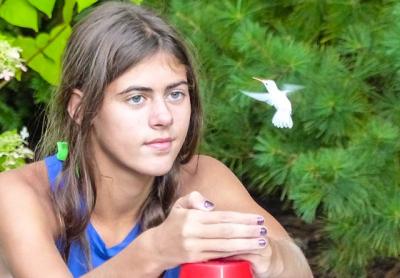Nature Notes: Rare White Hummingbird

Some of you may remember seeing the pure white stag that occupied the Village of North Haven for several years in a row about 25 years back. There was another similar albino deer inhabiting the northeast side of Accabonac Harbor, a few years later.
There have also been several partially white deer, grackles, turkeys, and a handful of other wild animals around, not true albinos but leucistic, or partially white, including one spotted recently on Napeague.
Then there are a host of white birds we see all the time: mute swans, snowy egrets, great egrets, and various pigeons. Many species that live in the world’s boreal zone, such as polar bears, ptarmigans, snowy owls, beluga whales, ermines, and arctic foxes are white, but none of these are considered albinos. Whiteness in such species has its advantages, especially in snowy and icy habitats.
On the other hand, if you are white like the North Haven stag and living in a gentler climate, such as we have on Long Island, you become a target. Maybe, that is why we see many more leucistic, i.e., semi-albinos, than pure albinos.
Albinism is a complete absence of melanin. It can occur in humans, too, and makes exposure to the sun for long periods dangerous.
In all my years of communing with natural history, here, on the West Coast, and in Japan and New Guinea, I have yet to encounter a true albino among the millions of birds, mammals, lizards, snakes, turtles, salamanders, frogs, toads, and fish that I have come across in the wild. In other words, albinos are extremely rare.
Almost anyone who been in close contact with an albino has experienced a Zen-like sense of wonderment. To be young and see an albino out in the wild is even more stirring. That is the case with Alexandra Carr, a 13-year-old teenager who was checking out the wildlife around the family property north of Abram’s Landing Road in Amagansett. Already a budding naturalist for many years, she was astounded to see a pure white hummingbird at one of the family’s assorted hummingbird feeders. The hummingbird was normal in every other respect — size, flight pattern, etc. — but pure white with red eyes and a pink bill, the characteristics of true albinism.
Hummingbirds the world over are among the smallest of birds. They are superb aerial acrobats, can hover for minutes on end, zoom in or away in the blink of an eye, and even fly backward if they have to. Obviously, such a tiny bird that nectars on flowers in the open has to have special abilities to avoid predation, and the hummingbird does.
Both Alexandra and her mother, Lisa Ann Carr, watched the white hummingbird for several hours as it came and went frequently to feed. At times it would fight with a normally colored female over the feeder. Then, both would feed together, within a foot of each other, before they resumed fighting.
The two took photos and videos of the tiny white bird. Alexandra went so far as to put a feeder in her hand as she sat motionless, letting the bird feed a few inches from her. I am reminded of the nuthatches, chickadees, cardinals, titmice, and downy woodpeckers that take seed from the outstretched hands of those visiting the Morton Wildlife Refuge. A combination of hunger and trust keeps such behavior going year after year. Obviously, the albino hummingbird trusted Alexandra to a similar degree.
It is the time for hummingbirds to migrate south. Some go all the way to Central America. The white hummingbird hung around for several days, but then disappeared. Maybe other humans to the south of here will be enchanted in the same way that Alexandra and her mother were as that tiniest of birds stops to feed along the way.
When I was pursuing a master’s degree at San Francisco State University in the early 1960s one of my professors was Robert Bowman, an ornithologist. He spent a summer on the Galapagos Islands with a graduate student and related to me that he could walk up to one of the Darwin finch species and pick up the perch it was sitting on without causing a flurry of flight and other evasive activity. Wild birds are not dummies. They are as sensate as deer, chipmunks, and almost all other vertebrates.
Alexandra is not so different from her teenage friends, but has a special fondness for birds, deer, and the natural world. Her mother shares her daughter’s fascination with all things living, which is a special bonus. It was my late sister, Margie, who took me for walks when I was 6 and 7 years old and introduced me to May pinks (trailing arbutus) and other wildflowers. That little bit of sisterly nudging led me into the wonderful world of nature.
Alexandra, you go girl!
Larry Penny can be reached via email at [email protected].
